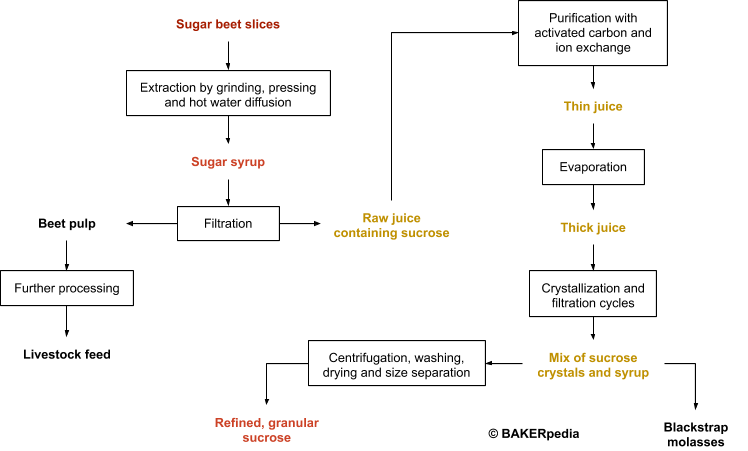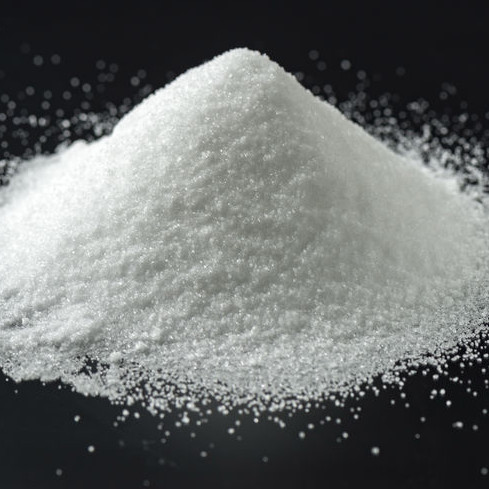Sugar
Also Known as Sucrose
What is Sugar?
Sugars are nutritive carbohydrates used by the baking industry to add sweetness, flavor, fermentable solids. They perform key functions in doughs and batters that improve the overall quality of the finished products.
Sugar has traditionally meant table sugar or sucrose. The U.S. definition of sugar includes all:
- Monosaccharides:
- Fructose, galactose and glucose
- Disaccharides:
- Sucrose, maltose and lactose
Origin
Sugars are found widely in nature. Here are the main sources:
| Carbohydrate | Origin / source | |
| Monosaccharides | Glucose | Building block of all disaccharides |
| Fructose | Found in fruits, maple tree and honey | |
| Galactose | Building block of lactose | |
| Disaccharides | Lactose | Milk sugar |
| Maltose | Found in cereals | |
| Sucrose | Found in sugarcane and sugar beets | |
Commercial production
Sugars are commercially produced using various technologies and sources. Sucrose, for example, is extracted from sugarcane and sugar beets. The process for the production of table sugar from sugar beets is as follows:

Function
Sugar is used in almost all baked products ranging from chemically-leavened sweet to yeasted goods. It performs key functions in bakery systems, including:1,2
- Food for yeast during fermentation to produce alcohol and CO2 gas to leaven dough
- Sweetener
- Humectant (through its hygroscopic nature)
- Creaming / tenderizing agent (aerator in batter systems)
- Shelf-life improver by binding free water and reducing water activity (natural preservative)
- Freeze-point depression
- Texturizer (mouthfeel improver)
- Color and flavor improver (through browning reactions like Maillard and caramelization)
- Foaming agent (along with egg whites) in sponge cakes
- Bulking agent
Nutrition and health
Sugars, like any other carbohydrate, are vital components of the human diet. They provide energy to sustain human life. Part of daily caloric consumption comes from sugars.
Excessive consumption of sugar in the diet may lead to metabolic imbalance. Current research suggests that in addition to risk factors such as smoking, genetics and sedentary lifestyle, a diet rich in sugars increases the risk of chronic diseases, such as obesity, diabetes, and cardiovascular disease.3
Application
Sugars can be added to bakery formulations in the following forms:
- Liquid forms
- Brown rice syrup
- Liquid sucrose
- Invert sugar syrup
- Molasses
- Honey
- Maple syrup
- Glucose or corn syrup
- High fructose corn syrup
- Dry (powder forms)
- Crystalline glucose
- Granular sucrose
- Brown sugar
- Lactose
Cake batters
Sugar is very important for creaming cake batters. During mixing, tiny air bubbles are trapped in the surrounding the sugar particles. CO2 gas released from the chemical leavening system and steam generated during baking fill these air bubbles to form air cells in the final cake. The smaller and more numerous the air cells, the finer the grain and the more tender cake crumb will be.
It also plays an important role in setting the final structure in cakes. The presence of sugar increases the temperature needed to gelatinize starch and to denature proteins in the batter. These physicochemical transitions are responsible for setting the cake’s structure.
Bread and buns
Sugar is vital for dough leavening through fermentation. With the short time dough processing systems found today, it is critical to provide accessible and easily fermentable sugars for yeast. Optimum product expansion of the product in the proof box and oven is a fine balance between sugar content, amount of yeast cells and their gassing power.
FDA regulation
In 2016, the Food and Drug Administration revised and amended the rule 21 CFR Part 101 on Food Labeling. The Agency gave food processors enough time to adapt and comply with the new nutrition and supplement facts labels requirements.
Two major changes are related to sugar:
- The Agency will be requiring the declaration of the gram amount of ‘‘added sugars’’ in a serving of a product, establishing a Daily Reference Value (DRV) of 50 g, and requiring the percent Daily Value (DV) declaration for added sugars.
- Changing ‘‘Sugars’’ to ‘‘Total Sugars’’ and requiring that ‘‘Includes ‘X’ g Added Sugars’’ be indented and declared directly below ‘‘Total Sugars’’ on the label.
References
- Mariotti, M., and Lucisano, M. “Sugar and Sweeteners.” Bakery Products Science and Technology, 2nd Edition, John Wiley & Sons, Ltd, 2014, pp. 199–220.
- Alexander, R.J. “Bakery and Other Grain-Based Products.” Sweeteners: Nutritive, Eagan Press Handbook Series, AACC International, Inc., 1998, pp. 45–61.
- BeMiller, J.N. “Carbohydrate Nutrition, Dietary Fiber, Bulking Agents, and Fat Mimetics.” Carbohydrate Chemistry for Food Scientists, 3rd Edition, Published by Elsevier Inc. in cooperation with AACC International., 2019, pp. 325–329.
- U.S. Food and Drug Administration, Changes to the Nutrition Facts Label, https://www.fda.gov/food/food-labeling-nutrition/changes-nutrition-facts-label. Accessed 17 September 2019.


